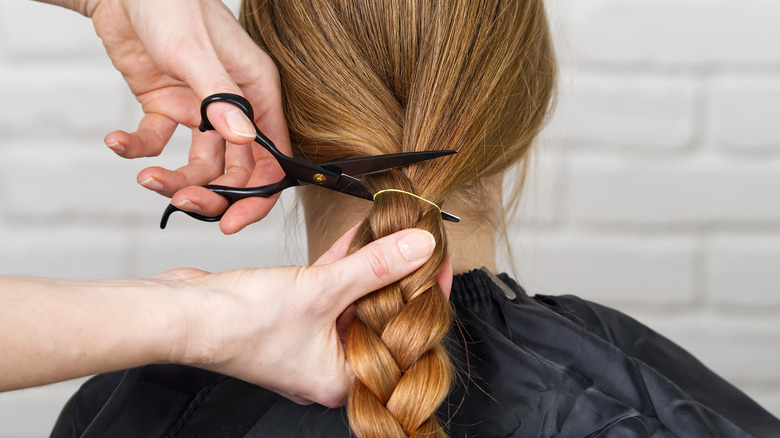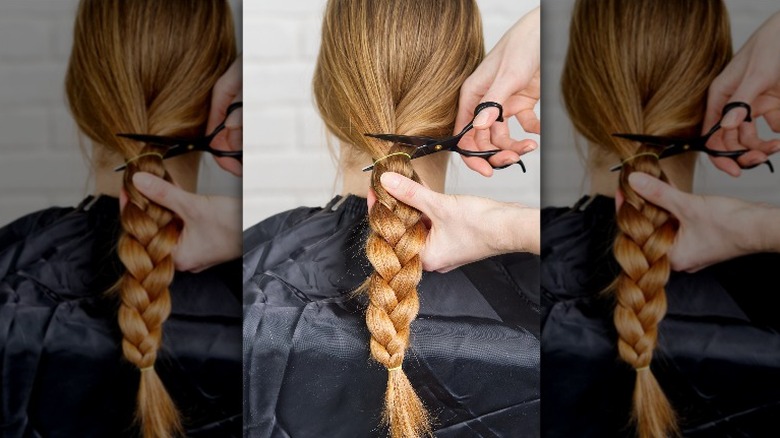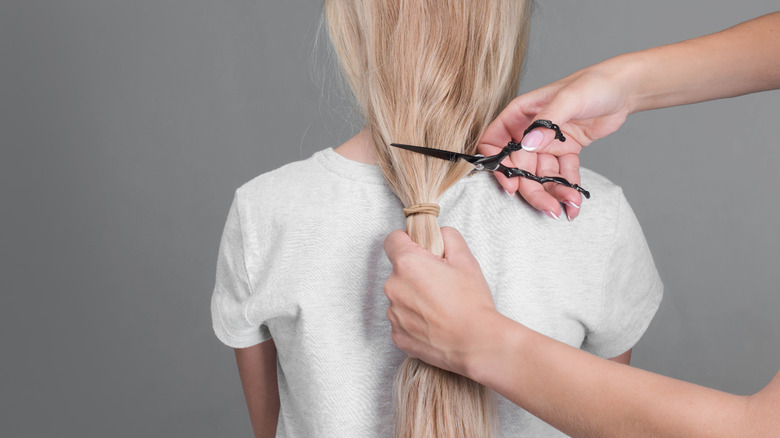Thinking Of Making A Big Hair Chop? Here's How Much You Can Make By Selling It
When you're looking to get some extra money quickly, one of the first options that probably comes to mind is selling your personal property. Depending on what you're putting on the market, you might come away with just a few bucks or a tidy bundle. (Your Beanie Babies probably aren't worth as much as you hoped they would be when you were collecting.) But even if you don't own an heirloom diamond ring, you do have something potentially valuable on your head: your hair.
According to Priceonomics, there's an enormous global market for human hair, since it's used for wigs and other purposes. (Commercial bakeries extract the amino acids in hair for use in bread and other products, via Vice; just don't think too much about it when you make your next sandwich.) Though much of the hair comes from India and China, you can contribute to the supply by selling your own. It's a practice almost as old as wigs themselves: A couple of centuries ago, French women's hair was sold at public auctions, per Smithsonian. Characters in classic literature like "Les Misérables" have sold their locks as sacrificial gestures. (Who didn't get misty-eyed at the scene in "Little Women" where Jo gets her hair lopped off to help pay for her father's medical expenses?) But if you're looking to follow Jo's lead, there are some things you should know before deciding to give up your crowning glory for cash.
How to get your hair buyer-ready
As with everything that seems too good to be true, there is a catch when it comes to selling hair. You'll probably need to let your 'do grow out: Long hair is more in demand than short. Most buyers are looking for hair samples at least 10 inches long, and preferably longer, according to Beauty Mag. Another key is condition; you'll command a higher selling price if your hair is "virgin," meaning never colored, processed, permed, or over-heated from dryers and irons. You can still market your hair as "non-virgin" for a lower fee, or, if you're willing to be patient, you can grow out your hair and leave it untouched until you have enough fresh growth to sell.
How much you'll get for your hair also depends on its thickness, texture and color. Thick, straight hair is preferred over thin or excessively curly strands. To gauge your hair's thickness, gather it into a tight ponytail, then wrap a measuring tape around the tied area. Red and blonde shades fetch more cash than brown or black, but there's a market for every shade, including gray.
While you're waiting for your hair to grow to optimal selling length, take the opportunity to pamper it. Wash it infrequently, and with a sulfate-free shampoo. Money Magpie suggests applying a natural oil to your hair and braiding it before bed for optimal moisturizing. Avoid hot rollers, curling irons, and other heat treatments, and get your ends trimmed every six weeks.
Sell your hair safely
Once your hair is ready for selling, the next step is to find the right buyer. Online hair-selling sites such as Online Hair Affair and Hair Sellon are one option, as are selling through Etsy or directly to a wig maker. When offering your hair for sale, include details of your hair length, thickness, color, and texture, along with any other relevant details. For instance, some sellers include information on their hair maintenance, as well as their nutrition habits and smoking history. (Taking vitamins and eating well can improve hair health, while smoking can cause hair loss.) Include a photo of your hair that shows off its color and condition.
To determine how much to ask for your locks, try a calculator such as the one offered by Hair Sellon or Beauty Mag. For example, a 12-inch bundle of 3-inch-thick virgin brown hair is worth roughly $176; however, other sellers opt to start high and see if they get any nibbles. The hair sites offer some cautions: Don't cut your hair until you actually have a legitimate offer. Use PayPal for payments; don't accept a money order or personal check. Once you're ready to cut, use a salon you trust, and make sure the stylist puts your hair in a ponytail and cuts it an inch and a half above the tied area. Have a sealable plastic bag ready to collect the ponytail, and follow the buyer's shipping instructions. Good luck with your big chop!


